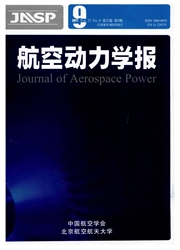

 中文摘要:
中文摘要:
描述了基于遗传算法的双层多孔介质骨架发散冷却的优化方法.冷却剂在固定压差(Be数)与多孔介质特征尺寸的条件下被注入固体骨架,通过改变多孔介质的材料、孔隙率和厚度比例,在满足固体骨架的质量和成本等约束条件下,以最低热端表面温度为优化目标,利用遗传算法找出可行的最优冷却结构设计.计算结果表明,靠近冷端的第一层多孔介质孔隙率应当尽可能的大以提高冷却剂流量,但是其组成材料对热端表面温度影响很小,而第二层靠近热端的多孔介质的组成材料对热端表面温度有很重要的影响,它的孔隙率取决与其对有效导热系数、冷却剂流量和内部热交换系数三方面影响的平衡.
 英文摘要:
英文摘要:
An optimization method of diffusion cooling with two layers porous matrix was presented in this paper. Coolant was injected into the solid matrix under certain differential pressures and characteristic sizes of the porous matrix. With the variation of the porous material, porosity and thickness ratio, the minimum temperature of the hot surface is ultimately subject to cooling optimization when the global constraint conditions of mass and cost, etc, are satisfied. In this paper, the genetic algorithm was used to find the feasible optimization design with the analytical solution of one--dimensional LNTE model. The results show that the porosity of the porous plate close to the coolant reservoir should be as large as possible, but this phenomenon is not correct on the porosity of the porous plate close to the hot surface, its value depends on the balance of effects on the effective thermal conductivity, heat convective coefficient and coolant mass flow rate.
 同期刊论文项目
同期刊论文项目
 同项目期刊论文
同项目期刊论文
 Synthesis and Microstructural Characterization of Ti-Al 3 Ti Metal-intermetallic Laminate Composites
Synthesis and Microstructural Characterization of Ti-Al 3 Ti Metal-intermetallic Laminate Composites Discussion of boundary conditions of transpiration cooling problems using analytical solution of LTN
Discussion of boundary conditions of transpiration cooling problems using analytical solution of LTN A discussion of transpiration cooling problems through an analytical solution of local thermal noneq
A discussion of transpiration cooling problems through an analytical solution of local thermal noneq Processing and mechanical behavior of laminated titanium-titanium tri-aluminide (Ti-Al-3 Ti) composi
Processing and mechanical behavior of laminated titanium-titanium tri-aluminide (Ti-Al-3 Ti) composi 期刊信息
期刊信息
